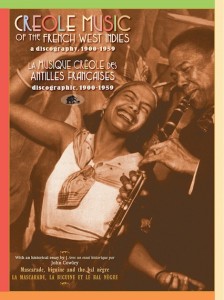 Black Caribbean musical traditions are rich in variety and the biguine, originating before emancipation, epitomises French Antillean Creole music. In this post Dr John Cowley, senior research fellow at the Institute of Commonwealth Studies, discusses his essay ‘Mascarade, biguine and the bal nègre’, which traces the music from its origins in the French Antilles to the upsurge in the genre’s popularity in Paris as a result of the Exposition Coloniale in 1931.
Black Caribbean musical traditions are rich in variety and the biguine, originating before emancipation, epitomises French Antillean Creole music. In this post Dr John Cowley, senior research fellow at the Institute of Commonwealth Studies, discusses his essay ‘Mascarade, biguine and the bal nègre’, which traces the music from its origins in the French Antilles to the upsurge in the genre’s popularity in Paris as a result of the Exposition Coloniale in 1931.
La Mascarade (en Françaises), the carnival held on the days immediately preceding Lent (Shrovetide) has been a communal focal point for centuries, especially in countries where the Roman Catholic creed predominates.
In the French Antilles it became a pivot for the intersection and development of Creole African and European performance traditions that began during the brutal period of African bondage and blossomed after the abolition of enforced servitude in 1848. Elements of these developments are explored in ‘Mascarade, biguine and the bal negrè’ essay (printed in French and English) which features in the newly published Creole Music of the French West Indies, A Discography, 1900-1959. The book will be launched on 23 January at Senate House (details below).
Focussing on the city of Saint-Pierre, which was destroyed in 1902 by a volcanic eruption that killed 30,000 people, the essay also examines African-Creole cultural practices that evolved in the course of celebrating the highly prominent carnival. By the end of the 19th century this festival was attracting many visitors from adjacent islands. Although arrested for several years by the annihilation of Saint-Pierre, Martinique’s musical and masquerade traditions have survived. In addition, similar customs existed in the French Antillean territories of Guyane and Guadeloupe and even in the autumn of 1902 a group of Martinique dancers and musicians visited Europe and performed traditional repertoire on the stage to raise funds for victims of the volcanic disaster.
From the turn of the 20th century, if not before, Paris had established itself as one of the world’s cultural melting pots; experimentation and novel artistic endeavour were rife in the periods before, between, and after each of the world wars. The city attracted creative personalities from Europe and the Americas, as well as from the French imperial colonies, including those in Africa and East Asia. Likewise, the City of Light attracted many South American artists who came to learn from, or exchange ideas with, leading practitioners from other continents who were based there.
After the First World War, a community of black migrants from the French West Indies began to congregate in Paris. In 1923, for example, black women from Martinique and Guadeloupe were encouraged by entrepreneurs to come and work as ‘domestics’ in the metropolis. Antilleans were engaged in other enterprises too: during his 1924 stay in Paris the black American writer Langston Hughes took his first job as a doorman at a club on the rue Fontaine run by a Martiniquaise.
In that same year, Jean Rézard des Vouves, a Martinique political hopeful, student, and amateur pianist, rented a back room of a ‘bougnat’ (a small bistro) at 33 rue Blomet (15e), belonging to Monsieur Alexandre Jouve (likewise active politically) and run by an Auvergne native. Des Vouves’ intention was to hold rallies pending his candidature for the French Chamber of Deputies. The political meetings concluded with island-style music-making and dancing.
It was the success of these post-rally relaxations that led to the establishment of the Bal Nègre, or Bal Colonial (it was known by both appellations), at the rue Blomet address, to which Des Vouves thereafter devoted himself.
Living also in the same street (at number 45) were several members of the Surrealist movement. In 1926, when the associated poet and writer Robert Desnoes moved there and wrote a newspaper article about the dance place, the Bal began to become known outside the circle of black French Antillean and Africans who were its regular habitués.
Featuring a variety of dances, including the beguine, the Bal Nègre became a popular location for a diversity of local and visiting terpsichoreans. They included luminaries from the Harlem Renaissance who frequented Paris during the 1920s. The bal Blomet thrived as the centre of the burgeoning popularity of the biguine which was fuelled further by the Exposition Coloniale de Paris in 1931.
Elements of this music and folklore from the Antillean vernacular, together with later developments, are listed in the discography Creole Music of the French West Indies, a work which breaks new ground in the understanding of black music from the Caribbean.
The inventory, arranged alphabetically by performer, commences chronologically with a linguistic sample recorded on cylinder at the Paris Exposition Universelle de 1900. Folktales that were obtained in French islands using the same technique by the anthropologist Elsie Clews Parsons during the 1920s are also itemised — many had musical accompaniment, though the cylinders are lost.
Spearheaded by the first commercial recordings of the idiom, by L’Orchestre Antillais, direction: M. Stellio, almost one third the repertoire recorded commercially by Antillean musicians in Paris between 1929 and 1931 can be traced to political, satirical and marching chants from annual carnivals of the doomed city of Saint-Pierre. Songs from the same corpus were recorded occasionally into the 1950s, expressing the longevity of traditional carnival choruses and their distribution throughout the French Creole-speaking Antilles.
Despite the interruption of the Second World War (1939-1945), Paris remained the centre for the recording of French Antillean music. Following the cessation of hostilities and the beginning of economic recovery, during the 1950s studios in the outre-mer islands began to produce records aimed primarily at local markets reflecting economic and cultural changes in the new era.
The wide-ranging contextual content of Creole Music of the French West Indies — the discographical material gathered in collaboration with two French experts, Alain Boulanger and Marc Monneraye — makes this multidisciplinary work an essential handbook in the growing list of resources designed to explore the evolution of black music in the Americas.
Join us at the launch of Creole Music of the French West Indies, A Discography on 23 January 2015 at 6.00pm, Room 349 (3rd floor), Senate House, South Block, Malet Street, London WC1E 7HU. The event includes a panel discussion and is run in collaboration with the Institute of Latin American Studies (ILAS) and the Institute of Musical Research (IMR).
Dr John Cowley is an independent writer and researcher on vernacular masquerade and music traditions and their relationship to the Americas. Specialising in the Caribbean and North America, his study of the evolution of the Trinidad Carnival – Carnival, Canboulay and Calypso, was published in 1996. His essays appear in scholarly and popular books and periodicals and he compiles and edits CDs for labels such as Smithsonian-Folkways, Rounder and Bear Family Records.
